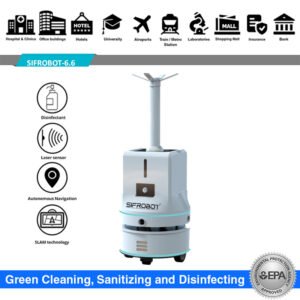Anti-epidemic Technology – SIFROBOT-6.6
With the full resumption of work, prevention and control of transportation hubs across the world are even more important. Despite the temperature measurement and control, it is difficult to rule out potential asymptomatic virus carriers. The risk of cross-infection always exists, and Anti-epidemic technologies has become the top priority of regulatory authorities at all levels.
It is precisely because of the hard work and inefficiency of manual disinfection, and the infection hazards caused by shuttles, fully automatic unmanned disinfection robots are widely used in this battle.
The disinfection robot is complex that’s designed of multiple high-precision technologies that integrate sensors and AI algorithms. On the other hand the mobile App was designed in consideration of the user’s convenience. The user only needs to set the daily disinfection time, and the robot starts disinfection regularly at the point, saving time and effort.
The actual calculation of the disinfection efficiency, the spray diameter of the disinfection robot is 6 meters, the optimal walking speed during disinfection is 0.3m/s, the average minimum disinfection area per hour exceeds 5000 square meters, the single full electric cruise is 5 hours, and the maximum disinfection area is 27000 square meters.
The volume of the disinfectant tank is 16L, and the average spray volume per hour is up to 3000ml, which can fully meet the needs of 5 hours of operation.
In addition to that, the large capacity liquid tank and super long cruise of The Anti-epidemic SIFROBOT-6.6 disinfection robot is suitable for the disinfection needs of large scenes such as train stations, high-speed rail stations, subway stations, and airports.
Based on the suggestions of the train station staff, the engineer selected the robot’s scene at the exit where there is a large flow of people. The field survey and decontamination range is about 140m and about 15m wide, and the overall area exceeds 2000㎡. The disinfection path should be flat and only partially blind. The robot can easily cross the 10mm ridge, and the disinfection work is not troubled.
The App operation interface deploys a disinfection route, and finally sets the start time. Considering the average train arrival interval of 20-30 minutes, the actual length of 140m takes about 10 minutes to complete a single run. At this time, the next train arrives. Hence, it will not affect the flow of outbound traffic. According to this rhythm, the route and time are deployed. The robot starts disinfection regularly, which solves the risk of cross-infection. The use of no residue and harmless disinfectant in densely populated areas is safe and healthy.
The epidemic is raging, but disinfection robots are also on the job. Every day, disinfection robots distributed all over the world work tirelessly to kill viruses at a fixed time, to protect human health and protect the peace of the earth.
If disinfection robots are available at 2,853 stations across the country, the safety of more than 20 million people will be guaranteed every day. Anti-epidemic technology is not a slogan. In the face of disasters, humans can use technology as a response weapon. If we had such a good helper at the beginning of the epidemic, there might not be a train suspension, large-scale isolation, and subsiding economy. The recession and later tragic stories.
[launchpad_feedback]

